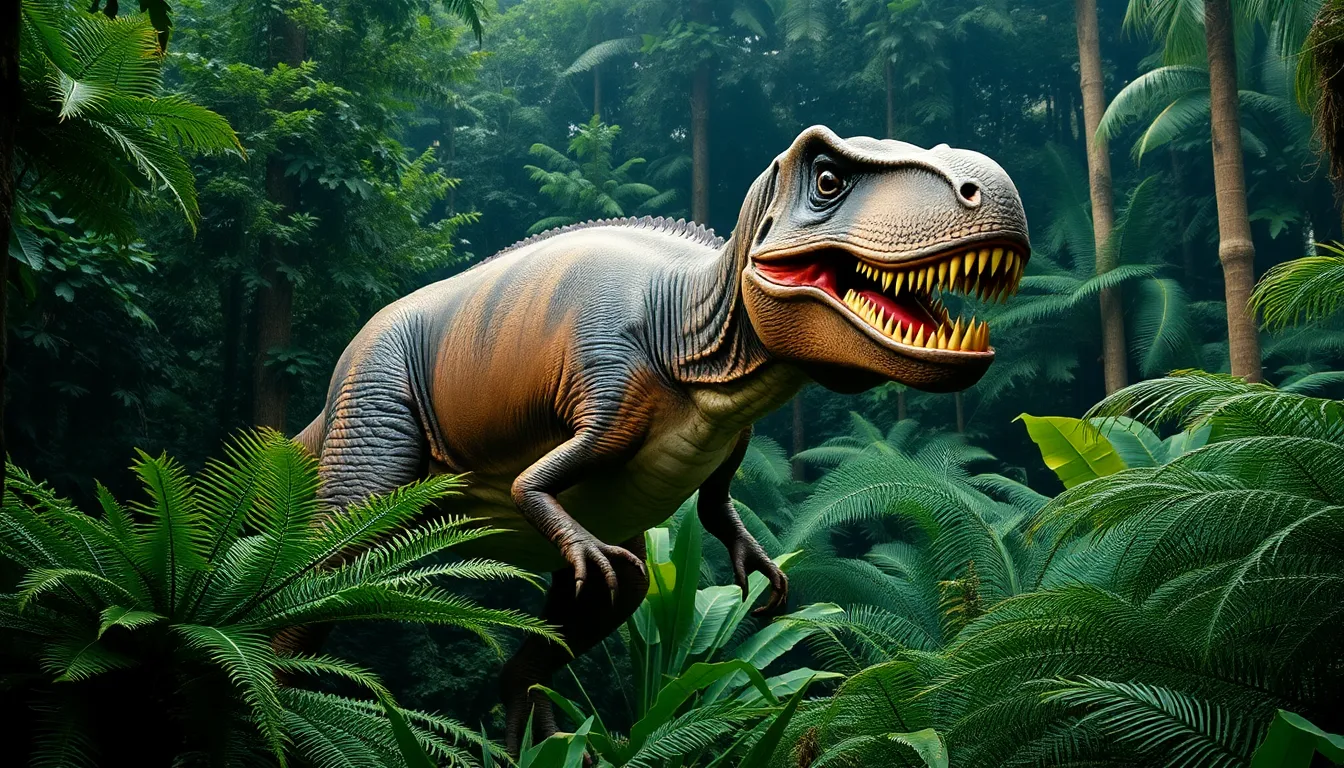In a year filled with cinematic gems, 1993 stood out like a neon sign in a black-and-white film. From heartwarming tales to epic adventures, this year had it all. But one movie captured audiences and box office gold, leaving a lasting impression that still tickles nostalgia.
Imagine a time when VHS tapes ruled the living room and blockbuster nights were a rite of passage. As popcorn flew and laughter echoed, one film emerged as the ultimate crowd-pleaser, stealing the spotlight and hearts alike. Ready to take a trip down memory lane? Buckle up as we dive into the number one movie of 1993—because who wouldn’t want to relive the magic of the past with a side of humor and a sprinkle of charm?
Table of Contents
ToggleOverview Of The Number One Movie In 1993
In 1993, Jurassic Park emerged as the number one movie, captivating audiences globally. Directed by Steven Spielberg, this science fiction adventure brought dinosaurs back to life through groundbreaking visual effects. Audiences experienced thrilling action and suspense, making it a cultural phenomenon.
Box office success marked Jurassic Park’s release, grossing over $1 billion worldwide. This achievement set a new record at the time, showcasing its massive appeal. Critics praised the film for its innovative technology and engaging storyline, which centered on a theme park filled with cloned dinosaurs.
The film’s iconic scenes, such as the T-Rex chase, left a lasting impression. Audiences remembered specific moments that blended thrills with awe. Not only did Jurassic Park entertain, but it also sparked discussions about scientific ethics regarding genetic engineering.
Additionally, the movie solidified its place in pop culture, inspiring a franchise that includes sequels, merchandise, and theme park attractions. Its influence extended beyond cinema, as it ignited interest in paleontology and sparked debates about evolution.
In various categories, Jurassic Park received critical acclaim, including three Academy Awards for its technical achievements. Recognition from the film industry underscored its significance in cinematic history. The soundtrack, composed by John Williams, enhanced the film’s emotional impact, further engaging viewers.
Overall, Jurassic Park defined the summer of 1993 and set precedence for future blockbusters with its blend of science fiction and adventure.
Cultural Impact

“Jurassic Park” significantly influenced the film industry and popular culture in 1993. Its achievements extend beyond mere entertainment, affecting various aspects of creativity and technologies.
Box Office Success
The movie grossed over $1 billion globally, making it the highest-grossing film of the time. Audiences flocked to theaters, demonstrating a strong appetite for innovative storytelling and visual effects. The success of “Jurassic Park” set a new standard for blockbuster films, leading to increased investments in special effects and CGI. This trend paved the way for future films to employ similar technologies, transforming audience expectations.
Critical Reception
Critics hailed the film for its imaginative storytelling and technical prowess. Renowned for delivering thrilling moments and engaging narratives, “Jurassic Park” earned three Academy Awards, highlighting its pioneering contributions. Reviewers often praised the seamless integration of visual effects with the storyline, enhancing the overall experience. As a result, the film sparked conversations about cinematic possibilities and advanced the industry’s techniques in filmmaking.
Key Themes And Plot
“Jurassic Park” explores themes of scientific ethics, human curiosity, and the unpredictability of nature. The film delves into the consequences of tampering with life through genetic engineering and raises important questions about responsibility.
Character Analysis
Dr. Alan Grant, portrayed by Sam Neill, demonstrates a strong sense of dedication to paleontology. His character evolves as he confronts the reality of dinosaurs in the park, showcasing both courage and a deep commitment to understanding these creatures. Dr. Ellie Sattler, played by Laura Dern, embodies intelligence and resilience, offering critical insights into the dangers posed by the park’s technology. John Hammond, depicted by Richard Attenborough, represents unchecked ambition, initially portraying enthusiasm for his vision yet ultimately revealing a flawed understanding of the repercussions. In contrast, Dennis Nedry, the scheming technician, illustrates greed and selfishness, serving as a catalyst for chaos. Each character contributes uniquely to the film’s narrative, highlighting diverse perspectives on the park’s ethical implications.
Significant Scenes
One iconic scene features the T-Rex breakthrough, a pulse-pounding moment where the dinosaur’s roar shatters the silence, leaving audiences in awe. This pivotal moment sets the tone for the chaos that ensues, combining suspense and visual exhilaration. The gripping sequence where the Velociraptors hunt the characters inside the park’s restaurant underscores the terror these creatures bring. Another unforgettable scene occurs during the herd of Gallimimus, highlighting the stunning visuals that captivated viewers. Each significant scene uses innovative special effects to enhance engagement, reinforcing the film’s masterful blend of storytelling and technological achievement.
Comparison With Other Movies Released In 1993
Numerous films also made their mark in 1993, competing with “Jurassic Park” for audiences’ attention. “Schindler’s List,” another Spielberg masterpiece, tackled profound themes related to the Holocaust and garnered seven Academy Awards, including Best Picture. While “Jurassic Park” dazzled with special effects, “Schindler’s List” moved viewers emotionally through its harrowing storytelling.
“Mrs. Doubtfire,” starring Robin Williams, provided a comedic counterpoint, attracting families with its themes of love and resilience. Its box office earnings reached $441 million, highlighting its broad appeal. With humor at the forefront, the film captured the spirit of the year.
On the action front, “The Fugitive,” with Harrison Ford, maintained a grip on the audience thanks to its suspenseful plot and strong performances. It earned an impressive $368 million, indicating a robust interest in thrillers during this period. Engaging action sequences coupled with a compelling narrative contributed to its appeal.
Animated features also garnered attention, especially Disney’s “The Lion King.” This classic enchanted viewers and grossed over $968 million worldwide, becoming a staple in family entertainment. Its memorable characters and music connected deeply with audiences, reinforcing its place in cinematic history.
As critical responses varied among these films, “Jurassic Park” stood out for its groundbreaking technology and storytelling innovation. Each of these films—whether tackling serious issues or providing lighthearted entertainment—showcased the diversity of cinematic offerings in 1993. The success and impact of these films reveal the competitive landscape of a transformative year in filmmaking.
Legacy And Influence
“Jurassic Park” established a monumental legacy in cinema, extending its influence far beyond 1993. The film’s innovative visual effects revolutionized industry standards. Audiences witnessed a transformation in storytelling, emphasizing high-quality CGI as an essential component of modern filmmaking.
Significant shifts in production practices occurred. Filmmakers increasingly prioritized special effects, leading to advancements that enhanced the viewer experience across genres. This focus on technology also inspired future blockbuster franchises eager to replicate “Jurassic Park’s” success.
Critical recognition further fueled its impact. Winning three Academy Awards highlighted the film’s technical mastery, reinforcing the importance of visual storytelling. Additionally, the memorable score by John Williams elevated emotional engagement, setting a new benchmark for soundtracks in cinematic history.
The cultural footprint remained strong, as “Jurassic Park” spurred interest in paleontology and discussions surrounding scientific ethics in genetic engineering. Characters like Dr. Alan Grant and Dr. Ellie Sattler prompted audiences to reflect on human ambition and responsibility.
Film critics frequently cite “Jurassic Park” as a catalyst for discussions about creativity and narrative depth in the industry. Iconic scenes, such as the T-Rex encounter, continue to captivate audiences, serving as benchmarks for suspense and visual excitement.
Merchandise and theme park attractions emerged from the film’s popularity, solidifying its place in pop culture. Future adaptations and sequels reflected the enduring appeal of its themes and characters. Each new installment sought to honor the groundbreaking origins while expanding the universe established in 1993.
The impact of “Jurassic Park” on cinema in 1993 cannot be overstated. It not only captivated audiences but also set a new standard for visual effects and storytelling that continues to resonate today. Its blend of thrilling adventure and thought-provoking themes has ensured its place in film history.
As a cultural phenomenon, “Jurassic Park” inspired a legacy that extends beyond the screen, influencing countless filmmakers and sparking interest in science and ethics. The film’s unforgettable moments and iconic characters remain etched in the minds of viewers, proving that its magic endures.
1993 was truly a transformative year in film, with “Jurassic Park” leading the charge and showcasing the power of innovative storytelling. This cinematic masterpiece invites audiences to reflect on the wonders of imagination and the complexities of human ambition.





